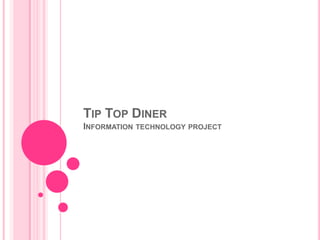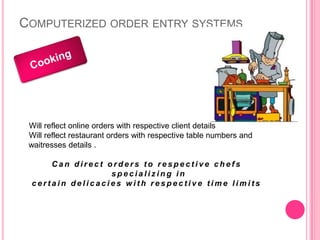Tip Top Diner - IT Solutions
- 1. TIP TOP DINER INFORMATION TECHNOLOGY PROJECT
- 2. THE CASE The Tip Top Diner - Busy restaurant situated in the downtown area of a major city. - Popular spot for lunch hour. The Main Objective To Provide Good Service At Low Cost and To Make A Profit of 10% of Total Sales
- 3. THE MAJOR CHALLENGES - To Provide adequate service to customers during the hectic lunch hour period -Often customers have to wait 20 to 30 minutes to get served. -Sometimes Items on the Menu are not available. -Much of the profit gets eroded by hiring additional part-time workers to handle the busy workload.
- 4. IDENTIFYING COMPONENTS & INTERACTIONS AT TIP TOP DINER ï‚¢ Waitresses Interactions ï‚¢ Dinning Component Facilities ï‚¢ Menu Items ï‚¢ Kitchen Staff ï‚¢ Food Supplies s ï‚¢ Kitchen Facilities ï‚¢ Manager
- 5. PAGING SYSTEMS To make Kitchen Staff & Waitresses more efficient.. Advantages: -The waitresses only have to go to the kitchen when they get paged to collect the dish. This gives them more time on the floor and attend to the clients. - It helps enhance service since the waiting staff is available on the floor for further orders and assistance. - Diners who receive good service spend additional money. - Communication from kitchen to dining room staff food is collected swiftly and reduces the likelihood of cold food arriving with the guest.
- 6. THE POS SYSTEM (POINT OF SALE SYSTEM) The most basic POS computer system is an electronic cash register. The clerk can ring up goods in the cash register and produce a receipt for the customer. At the end of the day, various cash register functions can be used to print out daily reports which are used to reconcile the cash register and to prepare a deposit. More complex cash registers are capable of extremely detailed reports, and they have memory functions which allow users to look up reports from the past, or generate monthly and yearly reports.
- 7. FOOD INVENTORY CONTROL SYSTEM -- Software that provides great set of tools for keeping an accurate inventory of food items. -- Maintain daily in flow & out flow of food items. -- Can evaluate quotations from several shortlisted vendors. -- Upon consumption can send direct orders to the vendor for required food items. -- Ensure consumption of perishable food items before their Expiry date. -- Can evaluate daily utilization of stock.
- 8. ONLINE FOOD ORDERING SYSTEM Detailed Menu Listing with prices Can choose to get it delivered or eat at the restaurant Pre payments can be made by credit card Can register and become members to avail special online discounts & offers
- 9. COMPUTERIZED ORDER ENTRY SYSTEMS Will reflect online orders with respective client details Will reflect restaurant orders with respective table numbers and waitresses details . Can direct orders to respective chefs specializing in certain delicacies with respective time limits
- 10. CUSTOMER SERVICE ENHANCEMENT A Prepaid card that can be purchased online at special rates in order to get fast & efficient services. The respective discounted amounts against the ordered dish will be debited as and when the customer uses it against the purchase. Can be issued for a month, quarterly, half yearly and annually Each card will also enable restaurant to remember the personal preferences of the customer holding the card as indicated by him/her. All customer loyalty card holders will get new menu. Prices and offer updates by SMS and Email.
- 11. CUSTOMER FEEDBACK To get insights of the customers on: • Food quality • Menu selection • Menu pricing and value • Waiting times • Promptness of service • Professionalism and friendliness of server(s) • Server's knowledge of menu • Decor • Restaurant location • Overall restaurant experience And then acting upon them to encourage: • Repeat business • Positive feelings towards the restaurant • Recommendations from current customers • Increased spending within the restaurant










